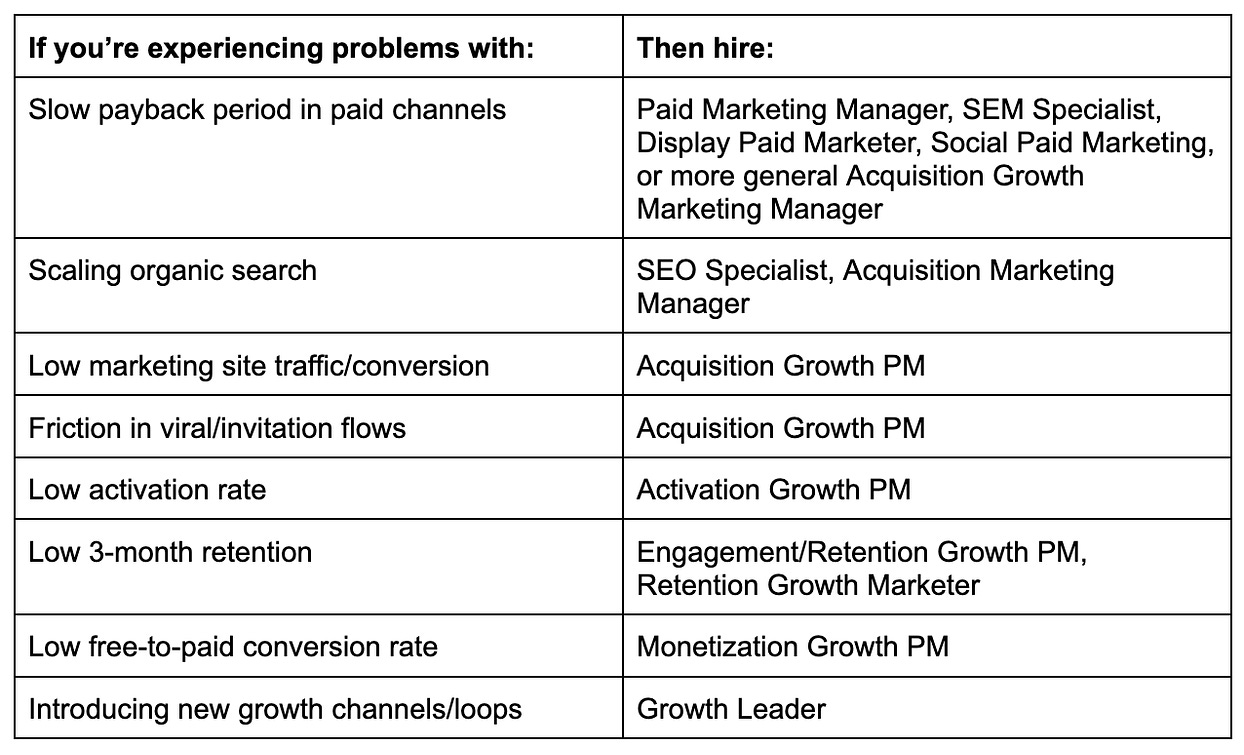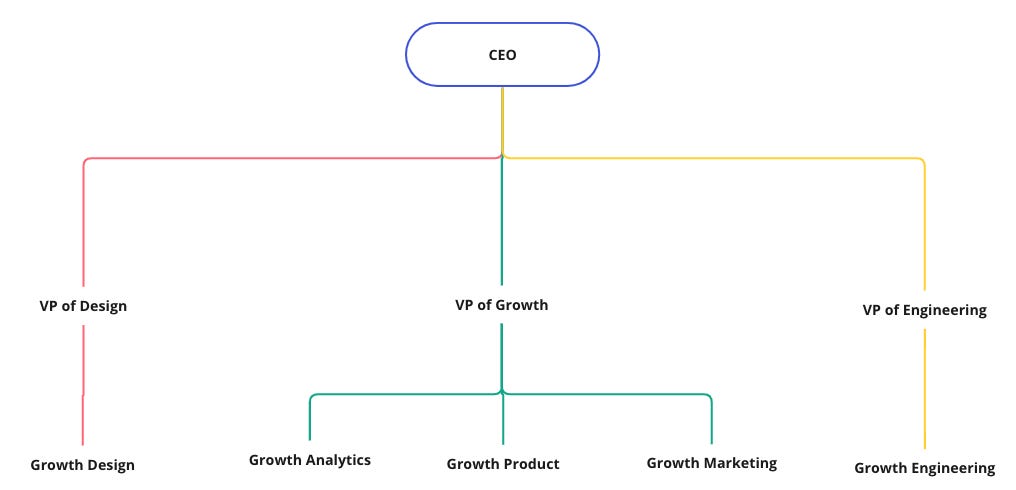Lenny's Newsletter - How to hire your first growth team
How to hire your first growth teamPractical advice from 12 world-class growth experts, including Lauryn Isford, Casey Winters, Melissa Tan, Adam Fishman, Laura Schaffer, John Egan, Hila Qu, Adam Grenier, and Ben Williams👋 Hey, I’m Lenny and welcome to a 🔒 subscriber-only edition 🔒 of my weekly newsletter. Each week I tackle reader questions about building product, driving growth, and accelerating your career. Scheduling note: We’ll resume the “Kickstarting and scaling a B2B startup” series next week.
This is a question that’s been asked and answered many times but, tbh, never super-well. To get you a full, complete, and lasting answer, I brought in the big guns—Elena Verna (legendary growth advisor/leader) and Andrea Wang (former growth leader at Amplitude and Lime, now a partner at General Catalyst). Elena and Andrea far exceeded my expectations in answering this question by personally interviewing 12 of the top growth minds in the world (plus tapping into their own experience), to lay out a detailed step-by-step guide for building your first growth team. A huge thank-you to Elena and Andrea for going the extra mile with this post and for being such great collaborators. Elena is a growth advisor and angel investor—you can find her on LinkedIn and Twitter, and don’t miss her amazing newsletter, Elena’s Growth Scoop. Andrea is a partner at General Catalyst, investing in early-stage B2B startups, who loves helping companies think about product and growth strategy—you can find her on LinkedIn and Twitter. Growth, as a function, is only a decade old. Many companies are establishing growth teams for the very first time, and there’s still very little practical advice for thinking through the timing and sequence of building your first growth team. We decided to leverage our experience and the expertise of top growth practitioners, including Adam Fishman (Lyft, Patreon), Adam Grenier (Eventbrite, Uber), Ben Williams (Snyk), Casey Winters (Pinterest, Grubhub, Eventbrite), Hila Qu (GitLab), Laura Schaffer (Amplitude, Twilio), Lauryn Isford (Airtable, Notion), and Melissa Tan (Webflow, Dropbox) to help you get started. What does a growth team do?Growth teams don’t build net new products or features. Instead, they work on creating distribution strategies that help acquire, activate, engage, and monetize customers on the existing product value.
Growth teams and pods are typically formed around (1) acquisition, (2) activation, (3) monetization, and/or (4) engagement goals. And 90% of the time, acquisition is the first goal new growth teams take on. This is our recommended approach as well, because:
How does growth look at different company stages?Growth efforts and team compositions vary depending on the stage of a company’s development. Just like with the first product or marketing hire, it is a difficult decision to determine when growth specialization and hiring are worthwhile. Here are our guidelines: Before PMF: Develop a growth model hypothesisMany founders get caught up in growth hype and try to hire growth talent as early as possible. Don’t fall victim to this trap—you will only waste precious capital and equity for lackluster results. Growth is about increasing the distribution of the core product. If there is no validation that the product has found PMF, growth has nothing to grow. PMF has to happen first, then growth. But that’s not to say you shouldn’t think about growth pre-PMF. As you explore potential product-market fit, it is crucial to have hypotheses on how you will distribute your product. For example, if you are planning to be product-led, then the product has to be designed with acquisition, monetization, and retention distribution goals in mind from the very beginning. If you are planning to be marketing/sales-led, then the product experience will look very different from inception, as you will have humans responsible for growth levers and distribution. Founders must assess their PMF strategy and develop the best-fitting ways to distribute the product to create predictable, sustainable, and defensible growth. It can be product-led, marketing-led, sales-led, or combinations thereof. But just like you wouldn’t outsource your PMF to a PM, you cannot outsource your initial growth ideas. Finding PMF: Founder-led growthDuring early signs of traction and initial scaling stages, it is important to validate that the growth model hypothesis was correct. Founder-led growth is the best path here, where the founder drives growth efforts across product-led, marketing-led, or sales-led motions.
The benefit of founder-led growth at this stage is quick decision-making, tight alignment to vision and customer, and, perhaps most importantly, leading by example to set up the growth mindset within the company culture. At this stage, we recommend you don’t hire a team for growth, as it’s still too early in the PMF journey to warrant multiple headcounts, but if you still want to hire dedicated growth talent, look for someone with (1) high iteration/learning velocity; (2) a growth mindset; (3) strong execution skills, and a generalist who can execute across different growth problems; and, ideally, (4) someone internal who already has the business context. Scaling PMF: Hire your first full-time growth rolesAs your company efforts transition from a search for and validation of PMF to scaling work, you can begin hiring your growth team. In other words, the right time to think about the first growth hire is when you are ready to blow up the distribution of your current product-market fit and have initial validation of your distribution methods. Your first growth hire’s skill set should be anchored to the biggest growth lever that is currently experiencing friction: acquisition, activation, engagement, or monetization. Is your biggest bottleneck to growth today acquiring new users, activating those users, keeping them retained, or generating revenue? It is important not to hire growth team members just to “accelerate growth,” as it will likely result in a misfire. For example, if product-led growth is your main motion, hiring a marketer to accelerate growth will lead to disappointing results—because most of the growth work will need to be done in the product by the PM and eng teams. Knowing where you are experiencing friction will ensure that you have sufficient data tracking and understanding of your growth model to bring the right talent on board, enabling new hires to have a meaningful impact. Suggestions on whom to hire depending on the problem: A growth leader should not be your first hireUnderstanding why your business is not growing is incredibly difficult. Many founders want to shortcut this by hiring a growth leader to outsource solving this problem to them. Unfortunately, even the most experienced growth leaders will take at least 6 to 12 months to understand the local problem fully. The business ecosystem is incredibly complex, and learning about products, industries, markets, customers, and internal employee dynamics is not an easy feat. When growth leaders need immediate results, they are forced to simply copy-paste from their previous experiences, often resulting in initiatives that do not produce desired outcomes. Sustainable growth is about evolution, not revolution. Hiring a “builder” profile (e.g. Acquisition PM, Activation PM, Monetization PM, Acquisition Growth Marketer, Retention Growth Marketer) as your first hire is a better bet. A builder is a growth generalist focused on broad tactical and execution skills within a specific domain. These are the individuals you want on your team when you are standing up growth processes and systems from the ground up. How to structure the growth teamSince growth is a result that the whole company contributes to, the question is how to structure the growth team to accelerate growth while also ensuring that the responsibility for growth is shared across the entire organization. Let’s take data analytics teams as an example. Although almost every company has data analysts, other team members also analyze data whenever possible. While the analysts may take ownership of the more complex data projects where they can provide unique insights, the entire company must take responsibility for data analytics if they want to make data-driven decisions. The same concept applies to growth teams. Growth teams take accountability over growth work where they can uniquely add value, yet the entire company should continue aligning to growth outcomes. There are two common archetypes of growth team structure:
Let’s explore the pros and cons of each archetype: Archetype 1: Centralized growth teamCentralized growth teams are optimized for velocity. Examples of companies that started with dedicated growth teams: Dropbox, HubSpot, GitLab, Miro, SurveyMonkey, Snyk Reporting structure: Growth marketing, product, and analytics report to a Head of Growth. Dedicated engineering and design resources are embedded in the team or may even report directly to the Head of Growth. The reporting structure can be either reporting to the CEO or a Marketing/Product/Revenue leader. Superpower: Velocity. They operate as a lean, mean, execution-hungry machine.
Drawbacks:
Archetype 2: Decentralized growth team...Subscribe to Lenny's Newsletter to read the rest.Become a paying subscriber of Lenny's Newsletter to get access to this post and other subscriber-only content. A subscription gets you:
|
Older messages
Monetizing passions, scaling marketplaces, and stories from a creator economy vet | Camille Hearst (Spotify, Patre…
Sunday, August 20, 2023
Listen now (64 mins) | Brought to you by Merge—A single API to add hundreds of integrations into your app | Coda—Meet the evolution of docs | Vanta—Automate compliance. Simplify security. — Camille
How to validate your B2B startup idea
Tuesday, August 15, 2023
Part two of my seven-part series on how to kickstart and scale a B2B business
Relentless curiosity, radical accountability, and HubSpot’s winning growth formula | Christopher Miller (VP of Pro…
Monday, August 14, 2023
Listen now (91 mins) | Brought to you by Vanta—Automate compliance. Simplify security | Sidebar—Catalyze your career with a Personal Board of Directors | Merge—A single API to add hundreds of
The ultimate guide to Martech | Austin Hay (Reforge, Ramp, Runway)
Monday, August 14, 2023
Listen now (85 mins) | Brought to you by OneSchema—Import CSV data 10x faster | Mixpanel—Event analytics that everyone can trust, use, and afford | Brave Search API—An independent, global search index
How the most successful B2B startups came up with their idea
Tuesday, August 8, 2023
Part one of my seven-part series on kickstarting and scaling a B2B business
You Might Also Like
🚀 Ready to scale? Apply now for the TinySeed SaaS Accelerator
Friday, February 14, 2025
What could $120K+ in funding do for your business?
📂 How to find a technical cofounder
Friday, February 14, 2025
If you're a marketer looking to become a founder, this newsletter is for you. Starting a startup alone is hard. Very hard. Even as someone who learned to code, I still believe that the
AI Impact Curves
Friday, February 14, 2025
Tomasz Tunguz Venture Capitalist If you were forwarded this newsletter, and you'd like to receive it in the future, subscribe here. AI Impact Curves What is the impact of AI across different
15 Silicon Valley Startups Raised $302 Million - Week of February 10, 2025
Friday, February 14, 2025
💕 AI's Power Couple 💰 How Stablecoins Could Drive the Dollar 🚚 USPS Halts China Inbound Packages for 12 Hours 💲 No One Knows How to Price AI Tools 💰 Blackrock & G42 on Financing AI
The Rewrite and Hybrid Favoritism 🤫
Friday, February 14, 2025
Dogs, Yay. Humans, Nay͏ ͏ ͏ ͏ ͏ ͏ ͏ ͏ ͏ ͏ ͏ ͏ ͏ ͏ ͏ ͏ ͏ ͏ ͏ ͏ ͏ ͏ ͏ ͏ ͏ ͏ ͏ ͏ ͏ ͏ ͏ ͏ ͏ ͏ ͏ ͏ ͏ ͏ ͏ ͏ ͏ ͏ ͏ ͏ ͏ ͏ ͏ ͏ ͏ ͏ ͏ ͏ ͏ ͏ ͏ ͏ ͏ ͏ ͏ ͏
🦄 AI product creation marketplace
Friday, February 14, 2025
Arcade is an AI-powered platform and marketplace that lets you design and create custom products, like jewelry.
Crazy week
Friday, February 14, 2025
Crazy week. ͏ ͏ ͏ ͏ ͏ ͏ ͏ ͏ ͏ ͏ ͏ ͏ ͏ ͏ ͏ ͏ ͏ ͏ ͏ ͏ ͏ ͏ ͏ ͏ ͏ ͏ ͏ ͏ ͏ ͏ ͏ ͏ ͏ ͏ ͏ ͏ ͏ ͏ ͏ ͏ ͏ ͏ ͏ ͏ ͏ ͏ ͏ ͏ ͏ ͏ ͏ ͏ ͏ ͏ ͏ ͏ ͏ ͏ ͏ ͏ ͏ ͏ ͏ ͏ ͏ ͏ ͏ ͏ ͏ ͏ ͏ ͏ ͏ ͏ ͏ ͏ ͏ ͏ ͏ ͏ ͏ ͏ ͏ ͏ ͏ ͏ ͏ ͏ ͏ ͏ ͏ ͏ ͏ ͏ ͏
join me: 6 trends shaping the AI landscape in 2025
Friday, February 14, 2025
this is tomorrow Hi there, Isabelle here, Senior Editor & Analyst at CB Insights. Tomorrow, I'll be breaking down the biggest shifts in AI – from the M&A surge to the deals fueling the
Six Startups to Watch
Friday, February 14, 2025
AI wrappers, DNA sequencing, fintech super-apps, and more. ͏ ͏ ͏ ͏ ͏ ͏ ͏ ͏ ͏ ͏ ͏ ͏ ͏ ͏ ͏ ͏ ͏ ͏ ͏ ͏ ͏ ͏ ͏ ͏ ͏ ͏ ͏ ͏ ͏ ͏ ͏ ͏ ͏ ͏ ͏ ͏ ͏ ͏ ͏ ͏ ͏ ͏ ͏ ͏ ͏ ͏ ͏ ͏ ͏ ͏ ͏ ͏ ͏ ͏ ͏ ͏ ͏ ͏ ͏ ͏ ͏ ͏ ͏ ͏ ͏ ͏ ͏ ͏ ͏ ͏ ͏
How Will AI-Native Games Work? Well, Now We Know.
Friday, February 14, 2025
A Deep Dive Into Simcluster ͏ ͏ ͏ ͏ ͏ ͏ ͏ ͏ ͏ ͏ ͏ ͏ ͏ ͏ ͏ ͏ ͏ ͏ ͏ ͏ ͏ ͏ ͏ ͏ ͏ ͏ ͏ ͏ ͏ ͏ ͏ ͏ ͏ ͏ ͏ ͏ ͏ ͏ ͏ ͏ ͏ ͏ ͏ ͏ ͏ ͏ ͏ ͏ ͏ ͏ ͏ ͏ ͏ ͏ ͏ ͏ ͏ ͏ ͏ ͏ ͏ ͏ ͏ ͏ ͏ ͏ ͏ ͏ ͏ ͏ ͏ ͏ ͏ ͏ ͏ ͏ ͏ ͏ ͏ ͏ ͏ ͏ ͏ ͏ ͏ ͏ ͏



